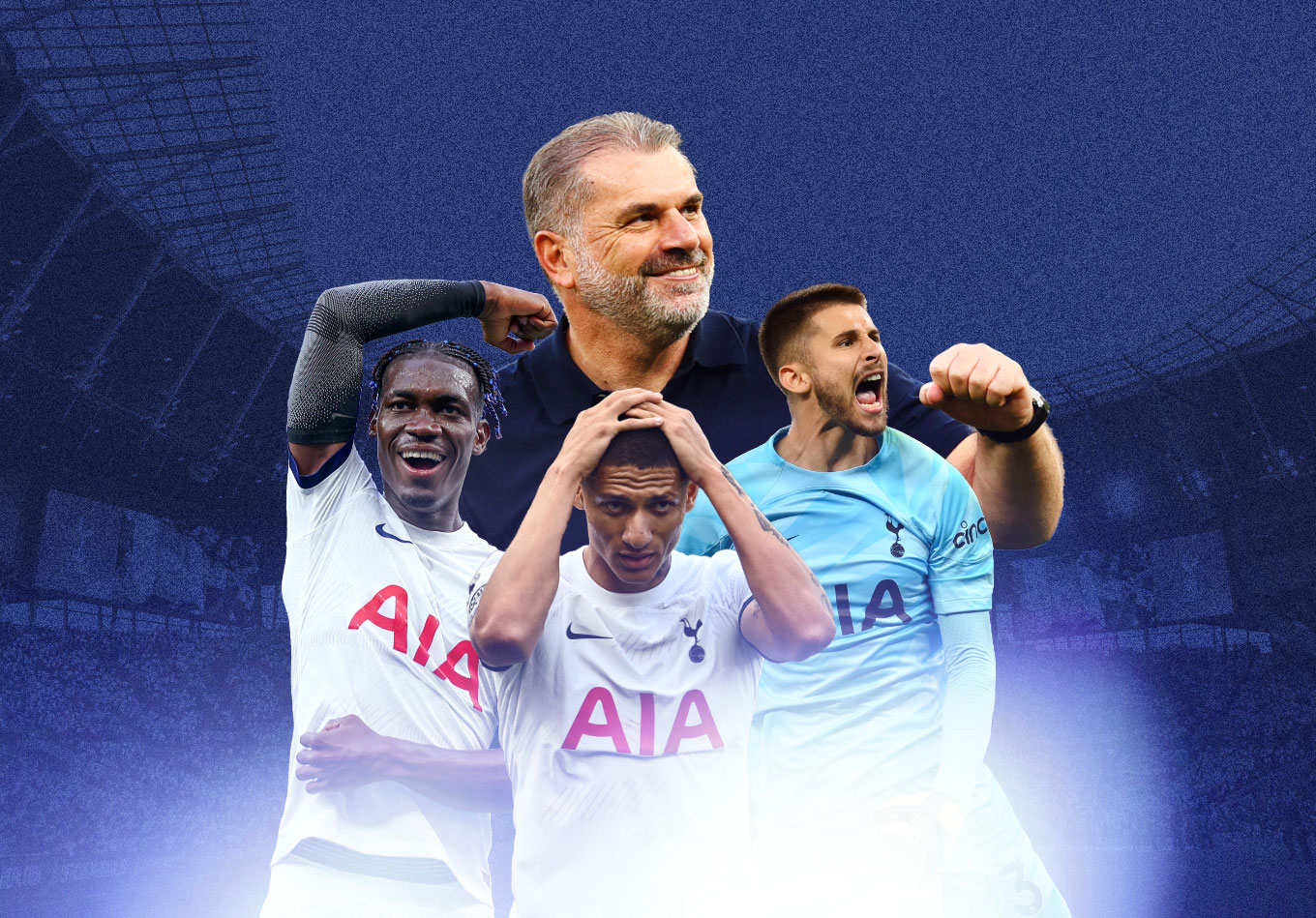Six wins from eight games and one of only two remaining unbeaten records mean Tottenham head into the October international break top of the table.
There’s no denying the turnaround under Ange Postecoglou has been sensational. In the space of one summer, the Australian has transformed Spurs from a reactive, underperforming, one-man team to a possession-based, thriving, collective unit, and the results so far speak for themselves.
But just how good have Tottenham been? Opta Analyst has taken a deep dive into the data to try and work out just how deserving Spurs are of their lofty position and, crucially, how long they can stay there.
The Good
The speed with which Spurs have taken to Postecoglou’s football has been quite incredible. He had endured slow starts in previous jobs and the expectation was that a Tottenham squad low on confidence after finishing eighth last season while playing a completely different brand of football would follow in the footsteps of Postecoglou’s previous teams and struggle to adapt quickly to Ange-ball.
But Spurs’ players looked comfortable playing this new style almost immediately. Compared to last season, they are having more possession, winning the ball in the attacking third of the pitch much more and having more touches in the opposition box.
Shots, goals and expected goals have all increased, too. Their field tilt, which measures a team’s possession in the attacking third compared to their opponents, has increased by more than 50%, suggesting they are keeping the ball high up the pitch and dominating territory far better than they were last season. We are only eight games into 2023-24, so the huge increases we’ve seen might drop as the season goes on, but the differences are so stark that they are worthy of discussion even at this early stage of the Postecoglou era.
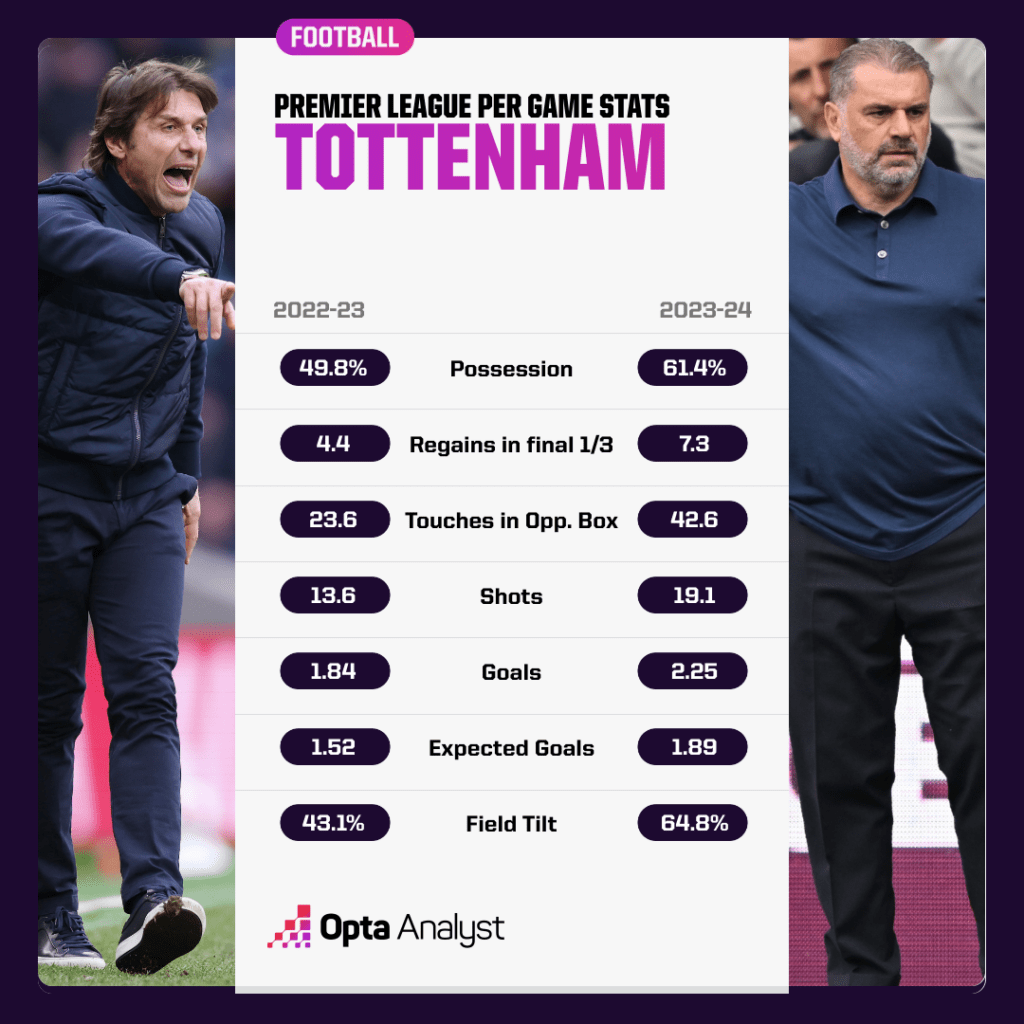
To anyone who has watched Spurs this season, these numbers won’t come as much of a surprise. The change in style has been obvious. Also, having more possession than last season and greater attacking intent wouldn’t have been that hard to achieve.
But Spurs are also outperforming many of their Premier League rivals this season as well as their own numbers from last season. They have the third-highest possession share (61.4%) in the Premier League behind Manchester City (64.4%) and Chelsea (63.5%), having ranked ninth last season.
And they are having possession in the right areas, too, playing high up the pitch whenever they can, which is testament to how well they have taken to Postecoglou’s football. They aren’t just keeping the ball at the back, but are pinning opponents back and playing in the opposition’s half. Spurs rank top of the Premier League for successful passes in the final third (1,192, or 149 per game) and touches in the opposition box (341, or 42.6). Their field tilt is the fourth highest in the league, at 64.8%.
Their shot tally of 153 (19.1 per game) is the highest in the Premier League, while they are third for non-penalty expected goals (15.1), behind Newcastle (15.9) and Brighton (15.8).
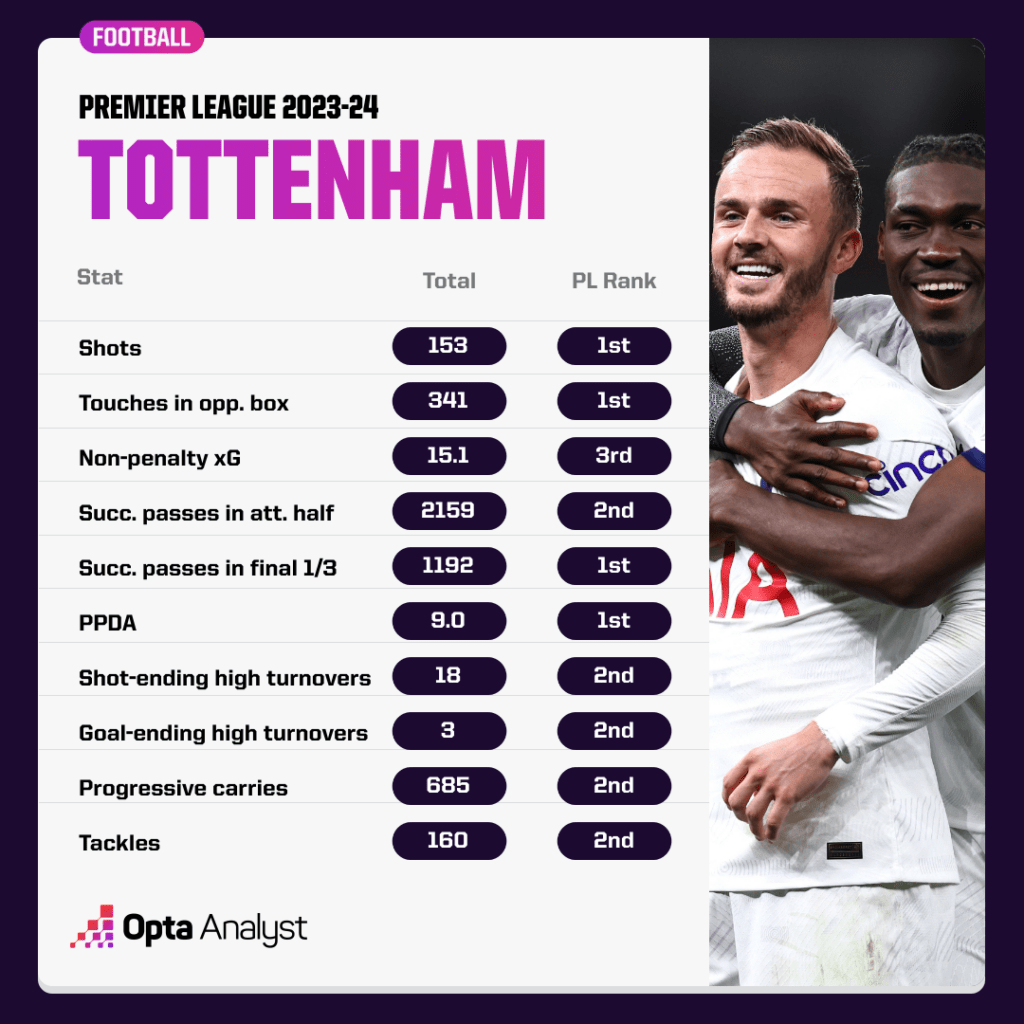
Many of those chances come from long periods of possession and an ability to play their way through the opposition, but they are also pressing effectively, too, and creating chances after turning the ball over. Their PPDA (passes per defensive action) of 9.0 is the lowest in the Premier League this season, showing that they are making attempts to win the ball back more actively than any other side. You have to turn those attempts to regain possession into something useful, though, and Spurs are doing that, ranking second in the league both for high turnovers leading to a shot (18) and high turnovers leading to a goal (3).
Perhaps the most impressive transformation, though, has been in Tottenham’s build-up play. They are passing out from the back with complete commitment, playing through the thirds and rarely going long. They are now dominating possession across the pitch to a far greater extent than they had done last season.
Postecoglou has given the players total confidence. His way of playing is bold; it involves his players taking risks on the ball in areas that might make some fans feel uneasy. But he insists his players shouldn’t worry about mistakes. He knows errors will come with learning his style of football and there will never be any punishment if his players lose the ball trying to play the right way.
“[Postecoglou] is telling us: ‘Just keep playing. If you lose the ball it can happen. Just try again. Keep trying, keep trying,’” centre-back Micky van de Ven said after the draw at Arsenal last month. “If we lose three balls in a row, he doesn’t want us to shoot the ball into the stands. We have to just keep playing.”
They have been daring in possession, and yet errors from players not used to playing this style of football have been largely absent. They have only committed two errors leading to an opposition shot this season – only four teams have committed fewer – and they are one of eight teams yet to concede a goal following a mistake. Last season, they committed more errors leading to an opposition goal (10) than any other team in the Premier League.
Admittedly, one of those errors leading to a shot came when Gabriel Jesus robbed James Maddison on the edge of his own penalty area in the north London derby, and the Brazilian blazed his shot over the bar when it looked easier to score. However, the point remains that those mistakes have not become common – they are still admirably rare.
The start of Pep Guardiola’s reign at Manchester City, by contrast, was littered with errors as he insisted his team get used to playing out from the back. Eight games into Guardiola’s first season in charge (2016-17), City had committed more errors leading to an opposition shot (five) than any other team in the Premier League.
In some sense, Postecoglou has actually been quite fortunate. Lots of City’s players didn’t look at all comfortable playing Pep’s football back in 2016, and while Postecoglou’s recruitment has largely been very good (Van de Ven, Maddison and Guglielmo Vicario have all started life at Spurs very well), he has also inherited a number of players who were purchased before he arrived and fit his style of play perfectly. Yves Bissouma, Destiny Udogie and Pedro Porro all spring to mind.
However, although Tottenham are top of the league, it hasn’t all been plain sailing.
The Not So Good
Vicario has been a huge success story since he arrived. Much of his impact has been with the ball at his feet; it’s fair to say that Tottenham simply wouldn’t have been able to play out the way they have been if Hugo Lloris was still in goal.
But he has also stood out for his shot-stopping. Rather too much, one might argue.
That is because Tottenham, for all of their attacking brilliance, are still conceding lots of chances. Seven teams have conceded fewer shots than them (104) and nine teams have conceded fewer shots on target (36). They have only the ninth-best record when it comes to expected goals against (11.1), and their goalkeeper ranks seventh for saves made (29).
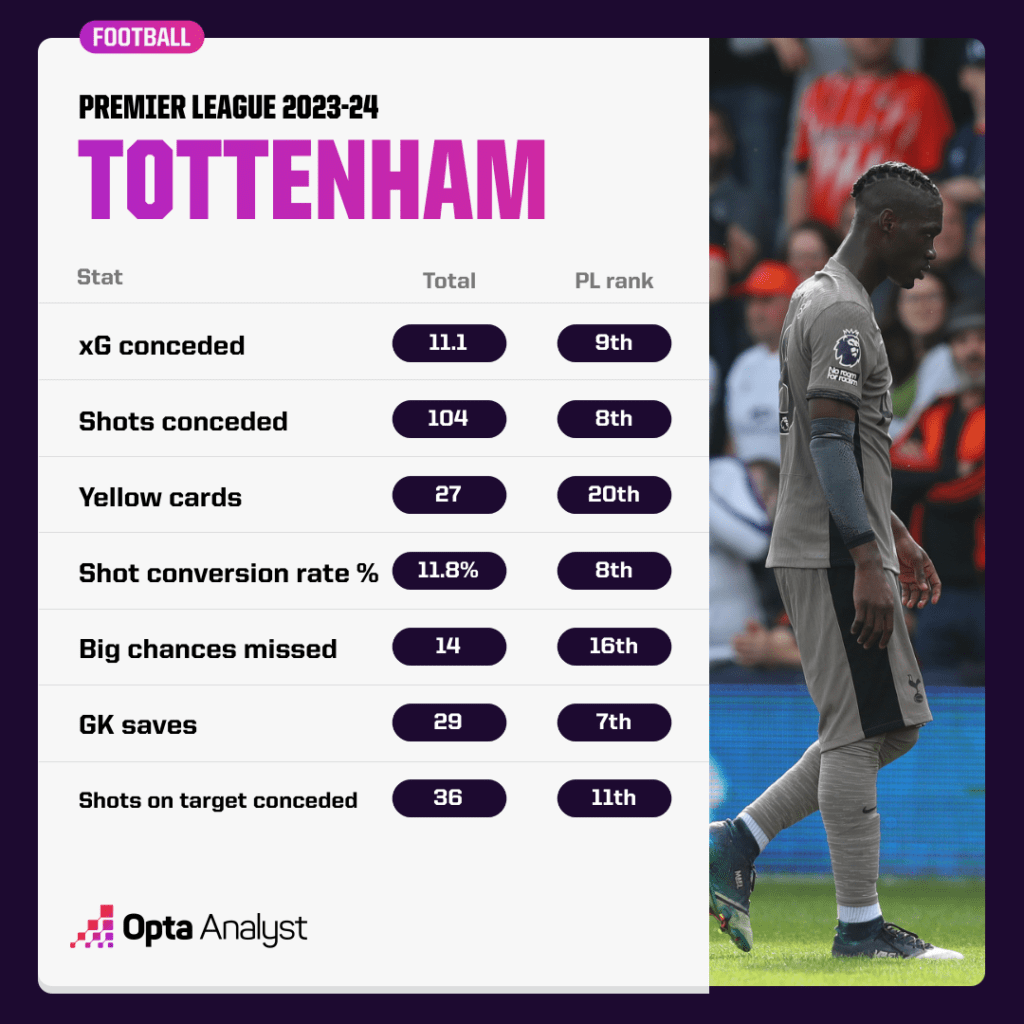
According to our expected goals on target model, only four goalkeepers have prevented more goals this season from the non-penalty shots on target they have faced than Vicario (2.5). In other words, Spurs might well have conceded 2.5 more goals than they have actually conceded were it not for Vicario’s shot-stopping. Those goals might have turned the 1-0 win at Luton into a draw and the 2-2 draw at Brentford into a defeat, for example.
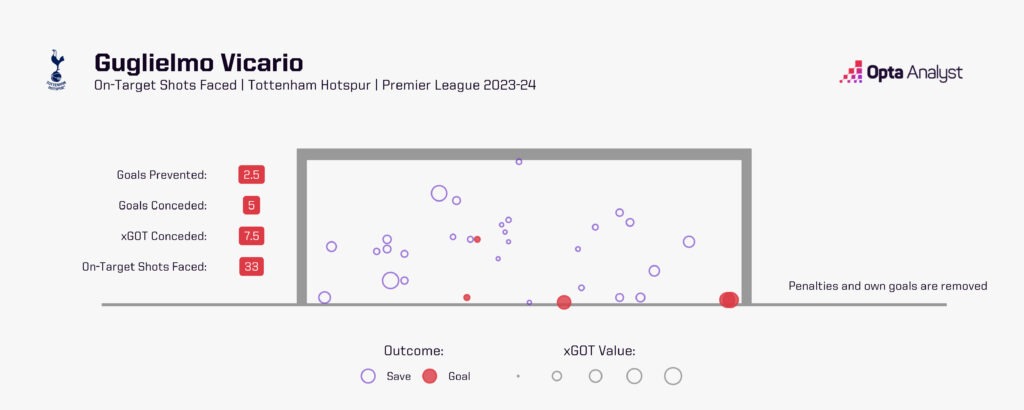
At the other end of the pitch, Spurs have been wasteful in front of goal. They have scored 18 goals but they have also already missed 14 big chances – defined as clear-cut chances a player would generally be expected to score – which is the fifth most in the division. Their shot conversion rate of 11.8% is bettered by seven other teams.
You could choose to look at these numbers with your glass half full, of course. It could be argued that it is a positive that Tottenham have created that many clear-cut chances, even if they are missing a lot of them. Last season, only two teams missed more big chances than eventual champions Manchester City (70). Spurs, meanwhile, ranked 11th (42).
Equally, though, Richarlison – responsible for missing four of those chances, including two huge ones at Luton on Saturday – hasn’t done much to convince us that he will eventually start finishing those chances if they keep coming his way. Harry Kane would often be among the league’s top scorers while also missing lots of big chances simply because he had so many.
Spurs have also received more yellow cards (27) than every other team in the league, and given their lack of depth compared to the likes of City, Arsenal and Liverpool, they could really do without too many suspensions. They are yet to play without Bissouma so far, but he will serve a one-match suspension against Fulham after his red card on Saturday, and he is one yellow card away from another ban.
Time will tell if Spurs’ openness at the back, profligacy in front of goal or ill-discipline become a problem.
The Caveats
There are some caveats to everything we’ve covered so far, the most obvious of which is the sample size we are dealing with. This strong start and the impressive – as well as not-so-impressive – statistics might not last. In time, we might see the extremes in Tottenham’s game levelling out.
On a not entirely unrelated note, the quality of opposition Spurs have faced is noteworthy. They have already played all three promoted teams plus Bournemouth – making up all of the league’s current bottom four – as well as Brentford, who are currently 15th. Someone might argue Tottenham should dominate games against those teams, and doing so shouldn’t be seen as a massive success.
It may be that, as the season goes on, Tottenham struggle to maintain the positive numbers mentioned above with regards to their possession, pressing, creativity and territorial dominance. As they play more games and face more high-quality opposition, it wouldn’t be hugely surprising if their numbers tail off.
There is also the caveat of the Liverpool game, and namely the failure of the VAR to award Luis Díaz the legitimate goal he scored. Things may have turned out rather differently had that goal stood. Spurs might not have won and might not be top of the league now.
It’s also worth mentioning some caveats to these caveats, though. Spurs have played Manchester United, Arsenal and Liverpool – three of last season’s top five – and they have dominated each of those games in different ways (though Liverpool were at least one man down for 64 minutes) and got positive results against all three.
They also have very little in the way of distractions for the coming season. They have no European football and are already out of the League Cup, so they have long breaks between league games, and up until new the year, when the FA Cup begins, lots of time to prepare on the training ground for each match. They only have 12 games left to play in more than 11 weeks left in 2023.
It’s impossible to say for sure quite how long Spurs can continue their current run of form. And given they are only top of the table because they have scored two goals more than Arsenal, it wouldn’t be surprising to see them fall off their perch in the space of the next couple of matches.
But 20 points from eight games is a fantastic record whatever the circumstances. It’s their best ever start to a Premier League season, after all. And they’ve done it despite all previous evidence pointing to the fact that Postecoglou’s teams in times gone by have started slowly. There are plenty of reasons to be optimistic about what’s happening at Tottenham.
Enjoy this? Subscribe to our new football newsletter to receive exclusive weekly content. You should also follow our social accounts over on X, Instagram, TikTok and Facebook.
